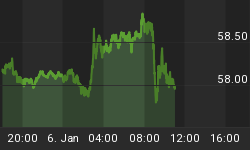The latest news headlines reflect a surging concern over the rising oil and gas price trend, including talk of the effects of high oil prices on domestic and global economic growth. This markets the first time the mainstream press has begun hand-wringing over the spill-over effects of a runaway crude oil bull market since the runaway first began. Is this "fear market" sending a message? Does the recent spike in fear-laden headlines indicate an imminent top (short-term) for the price of oil?
As an example, here are the editorial headlines from two consecutive issues of a leading mainstream financial magazine: "Optimistic businesses are revving up for growth." This was followed the next week by the following headline: "Oil could have global growth over a barrel." In just one short week the flavor of the headlines has fallen from bullish to bearish and all because of the oil market!
Here are some more recent oil headlines that seem to indicate an approaching top: "Bullish U.S. predicts $50 oil price next year," "Oil price jumps to record levels as analysts up estimates," "Inflation measure signals revival of price pressures," "Lack of new refining capacity puts pressure on supplies of oil, "Call for world to turn away from oil," and "Getting used to oil at $50." Indeed, you'd be hard pressed not to find a series of fear-laden oil headlines in any newspaper or news magazine in the country right now as the emotional response to the oil trend is exploding.
What are some technical indications for the near-term oil price outlook? Well the most glaring sign flashing in the charts right now is that rising wedge pattern that stretches back to the beginning of this year. Already this wedge has traced out the classic 1-2-3-4-5 alternation pattern typical of such patterns just before a reversal in price. Then there is the nascent parabolic dome, which indicates a short-term topping process.

Now what about the fundamental picture for crude? Are the supply situation really as tight as the pundits claim? For that we turn to the renowned economic forecaster Ed Yardeni of Oak Associates (www.oakassociates.com) who pointed out in his Investment Strategy Weekly of March 14 that "Oil prices are lower than they say."
Yardeni continues, "The growth in Foreign Official Dollar Reserves (FRODOR) is a great leading indicator of the level of CRB raw industrials spot price index (and the metals sub-index) 52-weeks ahead....The growth in FRODOR is also a 12-month leading indicator of the growth in world crude oil demand....In December, world crude oil demand was 4.2% above a year ago, the highest reading on record starting in 1987. FRODOR says, 'There could be a surprising slowdown in global oil demand growth, and a big drop in oil prices ahead.'"

This is the same message the chart and market psychology indicators are flashing right now, and it spells "fear market." And as we've all seen in the past year, whenever fear runs high at extremes, it typically invokes a reversal of the prevailing trend.
















